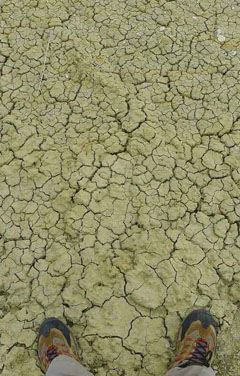Early the weekend before Thanksgiving, two SUVs loaded with junior geology majors, one professor, camping equipment and burrito fixings hit the road. The small caravan drives about three hours southeast, traversing interstate, state, county and local roads until finally, the asphalt ends.
 They head down Fish Creek Wash, a dry riverbed winding its way through dramatically deep stone canyons.
They head down Fish Creek Wash, a dry riverbed winding its way through dramatically deep stone canyons.
Destination? The final exam for Sedimentology. In the Split Mountain area of Anza-Borrego Desert State Park—California’s largest state park and second largest state park in the continental U.S.—students witness the geologic history of the arrival of the Colorado River and the development of the San Andreas Fault as Baja California was ripped away from the North American Plate, opening the Gulf of California, five million years ago.
“The importance of sedimentary rocks is that they are the Earth’s history,” says Associate Professor of Geology Robert Gaines. “What’s really cool about Pomona College is instead of having to look at some dusty old samples in boxes, we can go camping, and students can actually put their hands on a really complicated succession and try to figure out what was happening during the deposition of these strata, to reconstruct the ancient environments that were present by looking at signatures in the rocks.”
While the area Gaines and his students explore—which includes wind caves, slot canyons and fossil records like Ice Age mammal footprints—is only accessible to those driving high-clearance vehicles, Anza-Borrego is full of well-marked trails (including part of the Pacific Crest Trail) in its diverse 900 square miles extending from below sea level to 8,000 feet. The park is located mostly in eastern San Diego County, and first-timers can start at the Visitor Center in Borrego Springs for information on the natural history and highlights of the area. Consider visiting in February or March to experience the dramatic blooming of desert wildflowers like the chuparosa, chinchweed and dune evening primrose.
Call the Park’s wildflower hotline at (760) 767-4684,for updates on the seasonal blooms, or visit www.abdnha.org for more information.
